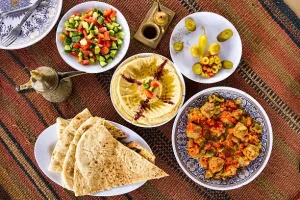The history of Jordanian cuisine is a fascinating tale of tradition, culture, and evolution. Rooted in Bedouin customs, trade routes, and diverse cultural influences, Jordanian food has developed into a rich and flavorful culinary experience.
At Janies Amman, we bring you the authentic taste of Jordan, preserving the deep culinary heritage passed down for generations. From mansaf, the national dish of Jordan, to the legendary zarb, a Bedouin-style underground barbecue, each meal carries a historical legacy that connects people through food.
Let’s take a journey through the history of Jordanian cuisine and uncover the traditions, ingredients, and flavors that make it truly special.
1. The Bedouin Influence – The Origins of Jordanian Cuisine
The history of Jordanian cuisine begins with the Bedouins, the nomadic desert tribes who relied on simple, nutritious, and long-lasting foods. Due to their mobile lifestyle, their diet consisted of meat, dairy, grains, and spices.
✔ Mansaf – The Ultimate Jordanian Dish: Originally a Bedouin specialty, mansaf is lamb slow-cooked in jameed (fermented yogurt), served over rice and flatbread. This dish symbolizes generosity and hospitality and is often served at special gatherings.
✔ Zarb – The Ancient Bedouin BBQ: A traditional underground cooking method, where meat and vegetables are slow-cooked in a sand-covered fire pit, infusing them with deep, smoky flavors.
✔ Arabic Coffee & Mint Tea: The Bedouins introduced strong black coffee with cardamom (qahwa) and refreshing mint tea, both of which remain essential to Jordanian hospitality today.
These Bedouin traditions laid the foundation for Jordanian cuisine, emphasizing simple yet rich flavors that remain a staple in modern Jordanian households.
2. The Influence of Ancient Trade Routes on Jordanian Cuisine
Jordan has always been a crossroads for civilizations, connecting Asia, Africa, and Europe. This strategic location allowed Jordan to become a melting pot of flavors, incorporating spices, grains, and cooking techniques from different cultures.
✔ The Silk Road: Traders brought rice, saffron, and dried fruits, which became essential in dishes like makloubeh (upside-down rice dish).
✔ The Ottoman Empire: Introduced kebabs, stuffed vegetables, and a variety of desserts still enjoyed today.
✔ Mediterranean Influence: Olive oil, chickpeas, and tahini became staples, giving rise to dishes like hummus and baba ganoush.
The history of Jordanian cuisine reflects this rich cultural exchange, blending local Bedouin traditions with foreign influences to create a unique and flavorful food culture.
3. Signature Dishes in the History of Jordanian Cuisine
As Jordanian cuisine evolved, it gave birth to several iconic dishes that have stood the test of time.
A. Mansaf – The National Dish of Jordan
✔ A dish of celebration, deeply rooted in Bedouin culture
✔ Tender lamb, cooked in jameed (dried yogurt), served over rice and shrak (thin bread)
✔ Symbolizes generosity and unity in Jordanian culture
B. Makloubeh – The Famous Upside-Down Dish
✔ A one-pot dish with rice, meat, and vegetables, flipped upside down before serving
✔ Introduced through trade with Persia and the Levant
✔ Aromatic flavors from spices like cinnamon and cumin
C. Falafel & Hummus – The Everyday Jordanian Snack
✔ Crispy chickpea fritters served with creamy hummus and fresh vegetables
✔ Popularized throughout the Middle East but has deep roots in Jordanian street food
D. Kunafa – Jordan’s Most Beloved Dessert
✔ A dessert made of crispy shredded phyllo dough, melted cheese, and sweet rosewater syrup
✔ A staple in celebrations, introduced during the Ottoman era
These dishes showcase the history of Jordanian cuisine, blending Bedouin simplicity with global influences to create meals that are both comforting and culturally significant.
4. Jordanian Hospitality – The Heart of Its Culinary History
Jordanian cuisine is not just about food; it is about community, generosity, and tradition. The act of serving food in Jordanian culture is a symbol of respect and hospitality.
✔ Guests are always welcomed with food and drink.
✔ Meals are traditionally served in large, communal platters.
✔ Sharing food is an essential part of family and social life.
At Janies Amman, we embrace this hospitality, ensuring that every meal is served with warmth and authenticity.
5. Experience the History of Jordanian Cuisine at Janies Amman
The history of Jordanian cuisine is a testament to centuries of tradition, adaptation, and cultural exchange. From its humble Bedouin roots to its modern-day popularity, Jordanian food remains a celebration of flavor, heritage, and community.
At Janies Amman, we bring the authentic taste of Jordan to Sarasota, offering classic dishes made with love and tradition.

Visit Janies Amman and Taste the Rich History of Jordanian Cuisine!
📍 Location: 1400 Dr Martin Luther King Jr Way Unit 107. Sarasota, FL 34234
📞 Call: +1 941-487-8073
🌐 Website: janiesamman.com
Come and explore the rich history of Jordanian cuisine at Janies Amman – where every dish tells a story of tradition, culture, and flavor!






